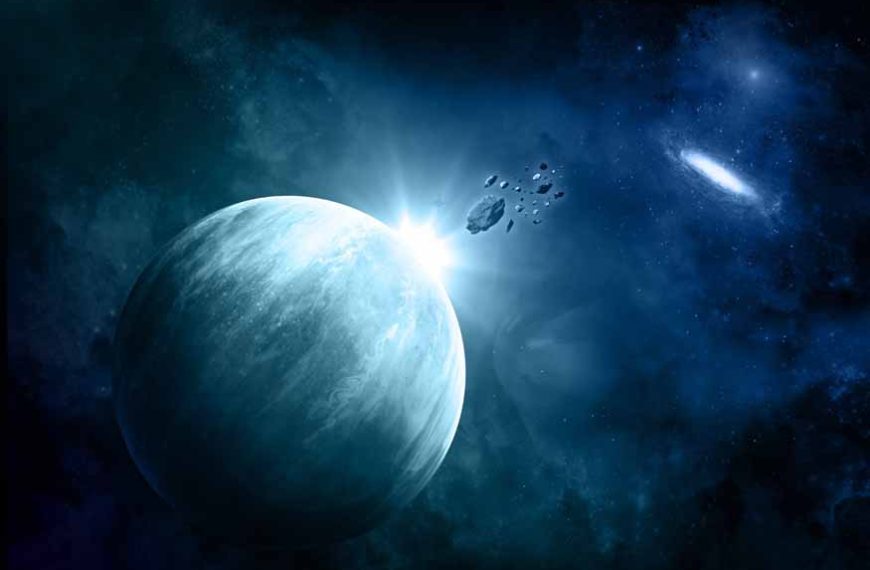Having ‘The Blues?’
There’s nothing like reading about something interesting, to lift your spirits!
Like, our upcoming exploration of the ‘Blue’ Planet.
For astrologers, Neptune is a Psychic planet of Spirituality and Compassion, and of Dreams, too. That’s not to say that Neptune holds any less charm for children. For them, answering the question ‘What colour is Neptune?’, excites them a great deal. The same excitement as the kind experienced by an astrologer, trying to determine the influence of Neptune in a client’s life!
There’s far more to this Blue Planet in our Solar System, than meets the naked eye. Or for that matter, its image under a telescope!
In this article, we propose to shed light on some fun Neptune facts, including Neptune Temperature, and reasons for that mysterious Neptune Planet Colour.
Let’s begin, with a closer look at what the planet Neptune is composed of.
Neptune: Its Composition
Neptune’s atmosphere is primarily composed of Hydrogen. The other gas present is Helium, commonly used to fill gas balloons at a child’s birthday party.
Dive deeper, and it’s a different story. There are heavier elements inside, including Methane and Ammonia. Also Water, that is responsible for the formation of Ice, as well as traces of Elements out of which Rocks and Metals are borne.
Note: It is the copious amounts of Ice found here that give Neptune the tag of ‘Ice Giant’, much like its Solar System counterpart, Uranus.
Neptune: Its Temperature
Since Neptune is given the moniker ‘Ice Giant’, as we have just seen above, it must be pretty ‘cold’, right?
Neptune Temperature, on an average, is – 214 degrees Centigrade. One might think that since it is the planet Furthest from the Sun, it must also be the Coldest. However, this is not so. It’s actually its neighbour Uranus, that is conferred with the title ‘Coldest Planet.’
A Long Summer
Just like the other planets in our Solar System, Neptune does not find itself parallel to the Sun, but rather inclined on its side, at an angle of 23.8 degrees. It is this very ‘tilt’, that gives rise to seasons on Neptune, like we have on Earth.
Interesting Fact: Did you know that the ‘Pole’ that is tipped towards the Sun, is actually hotter than the rest of the planet for an entire ‘Neptune Year’? Out there, it’s indeed a Long Summer!
Neptune: Its Colour
There’s no prizes, really, for guessing the answer to the question, ‘What Colour is Neptune?’
That uber cool Neptune Planet Colour, has indeed been a source of fascination, for children and adults alike. This Blue Planet in our Solar System actually gets its colour on account of the Methane that forms a considerable chunk of its composition.
It is this very Methane present in the upper atmosphere of Neptune, that is responsible for absorbing ‘Red Light’ from the Sun. What’s interesting here is, it reflects ‘Blue Light’ back into Space, which is the very reason Neptune appears Blue!
Fun Facts about Neptune
It might be the most distant planet in our Solar System, but that doesn’t make Neptune any less interesting than the other planets!
There’s plenty of cool information that you probably didn’t know about the Blue Planet, like the following:
- The Neptune Discovery Conundrum. Who really discovered Neptune? This has been a debate that has raged over the years. Galileo was the first person who might have seen it, but he recorded it as a ‘Star’ rather than a Planet. Perhaps the credit must go to the mathematicians Urbain Le Verrier and Couch Adams. They predicted that a new planet called ‘Planet X’, would be found in a particular location in the sky, where Uranus as we know it is located today.
- Its Gravity is almost like that on Earth. If you ‘could’ stand on Neptune, you probably ‘would.’ That’s on account of its gravitational force, that is eerily similar to that on Earth. Needless to say, if you did try something like that, you would fall right in. That’s because of it being a ‘Ball of Gas and Ice’, of course!
- Neptune has Rings, too. Move over, Saturn! You’re not the only planet with Rings. Neptune has its own system of rings. These include 5 main rings that are smaller and not as shiny as the rings of Saturn. Composed primarily of particles that are covered in organic material, they seem to emit a reddish glow.
- It has 14 moons. The largest of these is Triton, which is actually believed by some people to be a ‘captured dwarf planet!’
- It was not known to the ancient people Neptune was first observed in the year 1846. Like we have touched upon earlier, Neptune might have been discovered by the ‘Mathematician Duo.’ Hence, its position was actually pinpointed through the use of some pretty complex mathematical predictions.
- It has a Storm on its surface called ‘The Great Dark Spot.’ This is similar to The Great Red Spot found on Jupiter. What’s even more interesting to know here is, this spot is around the same size as our Earth!
- It is named after the Roman God of the Sea. This was actually done based on a suggestion by one of the people who were ‘supposed’ to have found it, the French mathematician Le Verrier.
- It’s the planet with the strongest Winds. A theory doing the rounds is, the extreme cold temperatures on the planet might reduce Friction considerably. Right to the point, where the setting is most conducive for the generation of those strong winds.
- It’s raining Diamonds on Neptune! Yes, you heard that right. The Carbon that is present is rendered by the environment into ‘Diamond Crystals’, that gradually make their way to the planet’s core.
At EuroKids, we believe that if you are teaching your children about planets other than the Earth, Neptune certainly merits an inclusion in the list. After all, it is the Outermost planet in our Solar System. Learning about it could help learn about Other Solar Systems, too.













